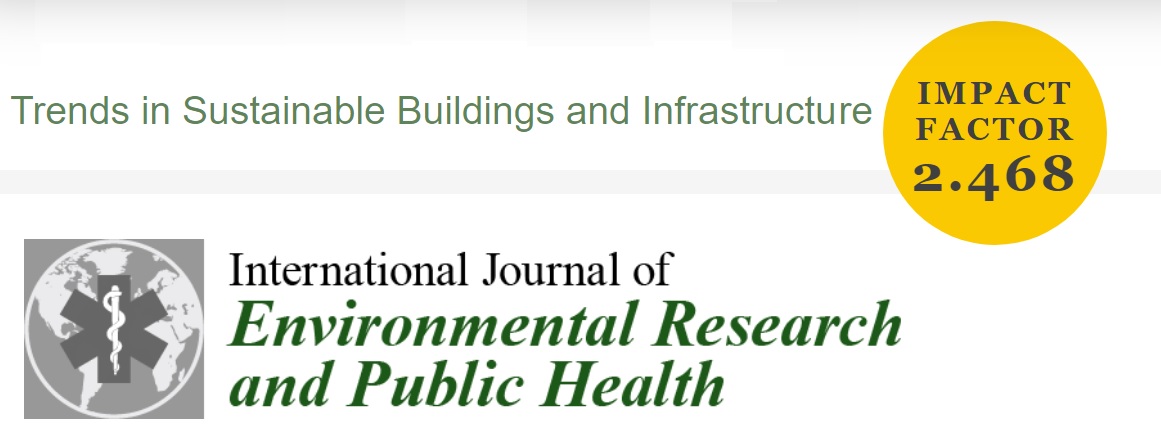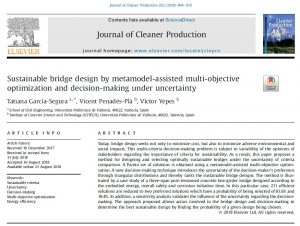 Acaban de publicarnos un artículo en el International Journal of Environmental Research and Public Health, revista indexada en el JCR. Se trata de la optimización multiobjetivo de pasarelas atendiendo al coste, las emisiones de CO₂ y la aceleración vertical causada por el paso humano. El trabajo se enmarca dentro del proyecto de investigación HYDELIFE que dirijo como investigador principal en la Universitat Politècnica de València. Se trata de una colaboración con la universidad Passo Fundo, de Brasil.
Acaban de publicarnos un artículo en el International Journal of Environmental Research and Public Health, revista indexada en el JCR. Se trata de la optimización multiobjetivo de pasarelas atendiendo al coste, las emisiones de CO₂ y la aceleración vertical causada por el paso humano. El trabajo se enmarca dentro del proyecto de investigación HYDELIFE que dirijo como investigador principal en la Universitat Politècnica de València. Se trata de una colaboración con la universidad Passo Fundo, de Brasil.
La tendencia hacia estructuras más sostenibles se está convirtiendo en una demanda creciente, y los ingenieros pueden aplicar técnicas de optimización para mejorar el proceso de diseño y dimensionamiento. Esto permitirá encontrar soluciones que reduzcan los costos y los impactos ambientales y sociales. En el caso de las pasarelas peatonales, es esencial garantizar el bienestar de los usuarios, además de cumplir con los estándares de seguridad, especialmente en lo que se refiere a las vibraciones humanas. Con este objetivo en mente, se llevó a cabo una optimización multiobjetivo de un puente peatonal de acero y hormigón. Se buscó minimizar el costo, las emisiones de dióxido de carbono y la aceleración vertical causada por la actividad humana. Se aplicó la técnica de Búsqueda de Armonía Multiobjetivo (MOHS) para obtener soluciones no dominadas y crear un Frente de Pareto. Se analizaron dos escenarios con diferentes emisiones unitarias obtenidas de una evaluación de su ciclo de vida en la literatura. Los resultados demuestran que, aumentando el costo de la estructura en un 15%, la aceleración vertical disminuye de 2,5 a 1,0 m/s². Para ambos escenarios, la relación óptima entre la altura del alma y la luz total se encuentra entre Le/20 y Le/16. La altura del alma, la resistencia del hormigón y el espesor de la losa son las variables de diseño que tienen el mayor impacto en la aceleración vertical. Las soluciones Pareto-óptimas mostraron una sensibilidad considerable a los parámetros variados en cada escenario, resultando en un cambio en el consumo de hormigón y en las dimensiones de la viga de acero soldado. Esto destaca la importancia de realizar un análisis de sensibilidad en los problemas de optimización.
Abstract:
The demand for more sustainable structures has been shown as a growing tendency. Engineers can use optimization techniques to aid in designing and sizing, achieving solutions that minimize cost and environmental and social impacts. In pedestrian bridges, which are subjected to human-induced vibrations, it is also important to ensure the users’ comfort, besides the security verifications. In this context, this paper aims to perform a multi-objective optimization of a steel-concrete composite pedestrian bridge, minimizing cost, carbon dioxide emissions, and vertical acceleration caused by human walking. For this, the Multi-Objective Harmony Search (MOHS) was applied to obtain non-dominated solutions and compose a Pareto Front. Two scenarios were considered with different unit emissions obtained from a life cycle assessment in the literature. Results show that by increasing 15% the structure cost, the vertical acceleration is reduced from 2.5 to 1.0 m/s2. For both scenarios, the optimal ratio for the web height and total span (Le) lies between Le/20 and Le/16. The web height, concrete strength, and slab thickness were the design variables with more influence on the vertical acceleration value. The Pareto-optimal solutions were considerably sensitive to the parameters varied in each scenario, changing concrete consumption and dimensions of the welded steel I-beam, evidencing the importance of carrying out a sensitivity analysis in optimization problems.
Keywords:
Multi-objective optimization; pedestrian bridge; sustainability; harmony search; carbon emissions
Reference:
TRES JUNIOR, F.L.; YEPES, V.; MEDEIROS, G.F.; KRIPKA, M. (2023). Multi-objective Optimization Applied to the Design of Sustainable Pedestrian Bridges. International Journal of Environmental Research and Public Health, 20(4), 3190. DOI:10.3390/ijerph20043190







